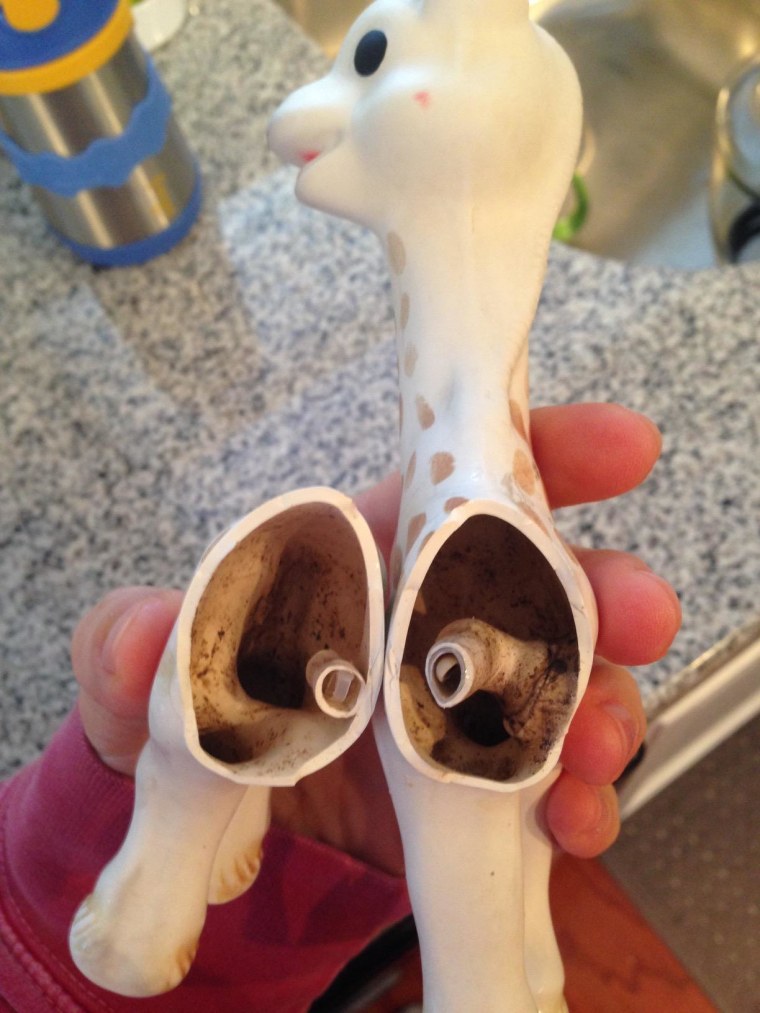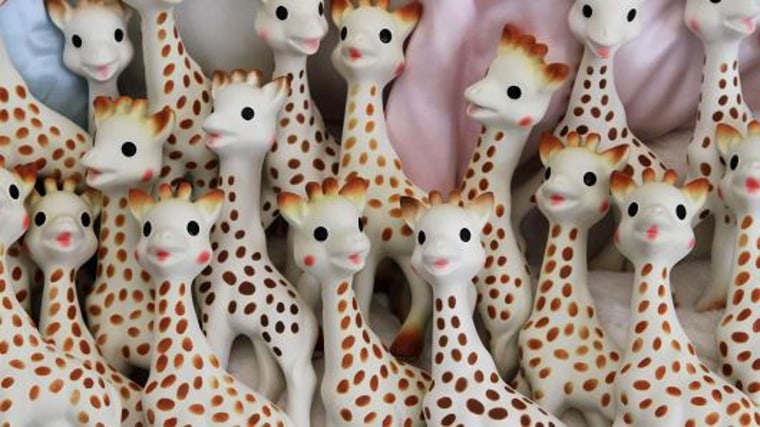Sophie the Giraffe is becoming an endangered species.
An article published this week by Good Housekeeping shared reports (and gnarly pictures) from parents of discoveries of mold inside the popular teething toy.
Disgusted at the mere thought of mold growing inside a toy meant for chewing and sucking on, some parents are tossing out their Sophie Giraffes without further ado.
While parents are doing a bit of grisly investigating, it seems that not every used Sophie toy has collected mold:
Some moms, like Jenn Morson Frederick, whose two-year old teethes on a Sophie doll, is fine not knowing — so long as there aren't any red flags.
"I could never murder Sophie," Frederick said, adding that a mom she's friends with went through with the dissection, and found no mold in her child's Sophie toy.
"[Our] Sophie the Giraffe smells lovely, so I am going to hope that she is still mold-free. Perhaps if I had a spare fresh one, I would [cut open] this one," Frederick said, alluding to a noteworthy fact: Sophie, whose proper name is Sophie La Girafe, isn't cheap.
Made by the French toy manufacturer Vulli, the toy retails for around $25 from retailers such as Target, Babies R' Us, and Amazon.
Keeping the Toy — and Its Image — Clean
Sophie also isn't low maintenance. At least, not according to Calisson Inc., the distributor in the USA of Vulli, which issued the following statement to NBC News:
"First of all, it’s important to know that ‘Sophie la girafe’ is composed of 100 percent natural rubber, so the cleaning instructions have to be carefully respected. As indicated on the packaging and in an explanatory leaflet inside the packaging, we recommend to clean the surface of ‘Sophie la girafe’ with a damp cloth. It should not be immersed in the water nor rinsed off, to prevent water from getting inside, as she may become damaged."
The Calisson spokesperson added that neither Dana Chianese nor Stephanie Oprea, the sources who shared their Sophie horror stories with Good Housekeeping, have been in contact with the company. Chianese did not return a message left by NBC News for comment. Oprea, who posted her review nearly a year ago, told NBC News she quickly ditched the moldy toy, which she said was a gift from a friend when her first son, now three years old was born. Her second, youngest son inherited the toy when he began to teethe.

"Everyone gives Sophie the Giraffe as a gift," said Oprea, speaking to the toy's incredible popularity (it's a bestseller in Amazon's baby and toddler toys category). "We had it for two years with my first son and then nine months after using it with my second son, we noticed a bit of a smell."
Then she sliced into it and found the moldy truth. She tossed the toy immediately and hasn't replaced it, nor will she buy any toy that has a porous opening and could breed mold.
"I don't allow bath toys that squirt water for the same reason," Oprea told NBC News. "It just never dawned on me that Sophie, not being a bath toy, would pose the same risks, but it makes sense with two kids drooling all over it."
Calisson insists that the mold depicted in the photos could not be caused only by a child's saliva.
"Based on the assessment the ‘Sophie la girafe’ quality department can make from the pictures shown in the [Good Housekeeping] article, it is not possible that saliva could cause the type of mold formation shown in the pictures," said the spokesperson.
"Internal studies have been conducted and indicated that it is improbable (or in really rare cases) that saliva can transform into mold. It seems that the inside body of the giraffe is still wet, which leads us to believe that there was presence of water inside the giraffe, which caused the mold. This situation is often seen with bath toys."
How Mold Works
Water and dark, cavernous places are breeding grounds for mold, notes Dr. Saul Hymes, assistant professor of clinical pediatrics at Stony Brook Medicine, but adds that seldom is saliva alone the cause for the growth of mold.
"Mold is probably getting in from the environment, not from your kid's mouth," said Hymes. "Where you live, where the toy goes, if there's any mold spores around [are all relevant factors]. It could be as simple as the toy being taken out more and exposed to the mold outside."
While Calisson advises not to immerse the toy in water, Hymes says soaking it in water that has either bleach or dish soap mixed in is the best way to effectively clean it.
"Don't just use water, as that promotes mold. Use a capsule of bleach or dish soap and squeeze the toy in and out while washing," said Hymes. "Let it soak for while, and then dry out."
It's also a good idea to wipe toys down every so often with a Clorox or other cleansing wipe, Hymes added.
Is Your Child at Risk?
The fact that Sophie the Giraffe has a porous opening is the reason that saliva — and anything else — is creeping in there. Hymes recommends that parents who want to be sure their kids' toys do not develop mold purchase products that are completely sealed.
But most likely, even if the toy is developing some mold, it's not something to panic over.
"The main issue everyone gets worried about is black mold and toxic mold," said Hymes. "But mold in this sense wouldn’t be something to worry about unless the kid has a major immune issue such as leukemia, cancer, [is on] chemotherapy, has had an organ transplant, or has an allergy to mold."
Hymes said that while he doesn't know exactly how many toddlers have allergies to mold, he suspects it isn't wildly common. He adds that usually general allergy panels that test for reactions to substances such as dust and pollen will also test for mold allergy.
"Allergies to mold look like most other allergies," said Hymes. "There could be red eyes, a lot of sneezing, and even a rash if the allergy is severe enough."
If your child is exhibiting any of these symptoms, take a visit to the doctor. And either way, keep those teething toys clean — all of them. Sophie the Giraffe may be the one under scrutiny at the moment, but it's likely not the only toy with potentially moldy issues.
"Any hollow toy that is rubber or plastic is receptive to mold growth," said Hymes. "It just happened to be that someone cut into Sophie and found it."
